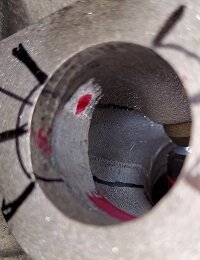Lastly without explanations I will include comparisons of the stock head, the Mod 12, and the Oval 1.
Brief description of each..
Stock- no description necessary.
Mod 12 - The Vaned head mentioned and shown previously.
Oval 1- This is the Mod 12 with the modification of the opening by adding an Oval shape.
That was somewhat blended but otherwise no changes. So basically the variations between
the Mod 12 and the Oval 1 are a result of modifying the opening from the "Vane" to the "Oval".
0mm @ .20 lift

20mm @ .20 lift

40mm @ .20 lift

60mm @ .20 lift

The Mod 12 is a high flowing head.
It flows 154 CFMs at .40 lift.
It has some known adressable issues that I am aware of, but overall flows very well, already outperforming Garrtt's D Port baseline.
Now the same comparisons at .40.
0mm @ .40

20mm @ .40

40mm @ .40

60mm @ .40

We can that there is an issue in the area around 40mm within the port as that is the only point at which the MOD 12 outperformed the Oval 1.
So between the 20mm zone and the 40mm zone we should be looking should we decide it is something needing to be addressed.
As the difference between the averages is only 4 CFM that may not be necessary.
Of course there could be specific points within the area we will want to address.
Lastly there is the velocity pattern shown at 60mm demonstrates the vaning created by the opening of the MOD 12 compared to the Oval1 design.
Brief description of each..
Stock- no description necessary.
Mod 12 - The Vaned head mentioned and shown previously.
Oval 1- This is the Mod 12 with the modification of the opening by adding an Oval shape.
That was somewhat blended but otherwise no changes. So basically the variations between
the Mod 12 and the Oval 1 are a result of modifying the opening from the "Vane" to the "Oval".
0mm @ .20 lift
20mm @ .20 lift
40mm @ .20 lift
60mm @ .20 lift
The Mod 12 is a high flowing head.
It flows 154 CFMs at .40 lift.
It has some known adressable issues that I am aware of, but overall flows very well, already outperforming Garrtt's D Port baseline.
Now the same comparisons at .40.
0mm @ .40
20mm @ .40
40mm @ .40
60mm @ .40
We can that there is an issue in the area around 40mm within the port as that is the only point at which the MOD 12 outperformed the Oval 1.
So between the 20mm zone and the 40mm zone we should be looking should we decide it is something needing to be addressed.
As the difference between the averages is only 4 CFM that may not be necessary.
Of course there could be specific points within the area we will want to address.
Lastly there is the velocity pattern shown at 60mm demonstrates the vaning created by the opening of the MOD 12 compared to the Oval1 design.
Last edited:



